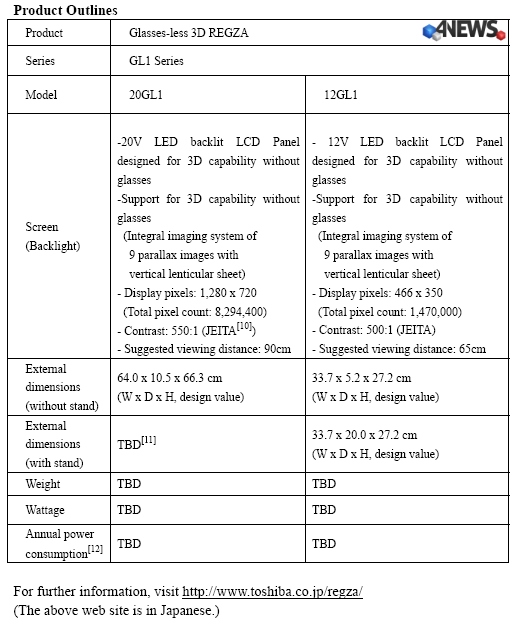 Disponibili a partire da fine anno 2010!
Disponibili a partire da fine anno 2010!
Oggi viene annunciato da Toshiba il 3D REGZA GL1, il primo 3D TV LCD in grado di visualizzare immagini in tre dimensioni senza l’uso degli occhiali.
E’ un grado passo avanti nel progresso tecnologico quello realizzato dall’azienda Toshiba, sempre votata alla ricerca e sviluppo di nuove caratteristiche.
I televisori sfruttano la tecnologia LCD con pannelli a diverse angolazioni di rifrazione in grado di far percepire all’occhio umano la profondità della terza dimensione.
I modelli annunciati sono il 20GL1 e il 12GL1, rispettivamente da 20 pollici e 12 pollici. Saranno in vendita già da fine anno 2010 in Giappone. Il prezzo non è stato ancora ufficializzato.
{vsig}tecno/audio-video/Toshiba3DTV-no-glasses{/vsig}
Di seguito il comunicato uffiicale:
-Toshiba’s new Glasses-less 3D REGZA GL1 Series to be available from end of December –
Tokyo–Toshiba Corporation (TOKYO: 6502) today unveiled the world’s first[1] LCD TVs that offer comprehensive 3D[2] capabilities without any need for dedicated glasses. The new “Glasses-less 3D REGZA GL1” series offers two models with screen sizes specifically designed for personal use: the 20-inch 20GL1 and the 12-inch 12GL1. Both TVs will be available in Japan from the end of December.
The new 3D TVs with no need for glasses employ an integral imaging system[3] and a perpendicular lenticular sheet[4] to display smooth, natural images, and Toshiba’s image processing technology to create nine parallax images[5] from the original content and create to 3D images. The result is precise rendering of high quality 3D images whatever the viewing angle within the viewing zone[2].
The 20GL1 integrates a high definition LED backlit LCD panel specially designed for 3D capability without any need for glasses that offers approximately four times the pixels of a standard Full HD panel. It also integrates the Cell REGZA Engine designed for 3D capability without glasses and based on the Cell Broadband Engine™[6] to deliver superior multimedia processing. The result of this combination is stunningly sharp, dynamic 3D images.
Toshiba will respond to various needs from the users for LCD TV with 3D capability. This will include larger screen models that use dedicated glasses and personal use LCD TVs without glasses, all offering dynamic, stunning image depth and high image quality. Toshiba will continue to draw on synergies of its semiconductor and image processing technologies to advance REGZA series as the cutting-edge of TV technology, and to create and deliver new value to the market by continuing to expand its line-up, and by anticipating and responding to user needs.
Product Outline
Glasses-Less 3D REGZA, series GL1 , Model 12GL1 and 20GL1, Screen Size 20-inch and 12-inch, Price Open, Launch in Japan December end.
Background to Development
Toshiba introduced the REGZA series as state-of-the-art TVs that make full use of synergies between its semiconductor and image processing technologies. Originally a 2D platform, REGZA TVs now deliver 3D images with superb quality to achieve an unsurpassed 3D experience.
Current 3D TV is based on active shutter glasses that deliver separate images to the left and right eyes. However, the market wants TVs that deliver the 3D experience without dedicated glasses across all content. In responding to this, Toshiba has adopted an integral imaging system that reproduces smooth, natural stereoscopic pictures, without any need for dedicated glasses. The company has channeled its initial efforts into personal-use 3D LCD TVs without glasses and is now commercializing 12- and 20-inch models. With these new TVs, Toshiba will seek to lead the market in 3D TV without glasses and to further increase its market share.
Key Product Features
1. The technology of 3D capability without glasses reproduces smooth, natural high quality 3D images
The new Glasses-less 3D REGZA GL1 series employ an integral imaging system and perpendicular lenticular sheet that can display natural and smooth high quality 3D images.
The integral imaging systems is based on the principal of sampling and collecting form several directions the light reflected from an object, and then faithfully reproducing the light through the display to realize smooth, natural images. Until now, conventional 3D technology without glasses has produced a fall off in image resolution and increased blurring[7] that has prevented practical use. Toshiba employs an LED backlit LCD panel specially designed for 3D content that systematically aligns pixels, and has also adopted a perpendicular lenticular sheet in order to realize precise rendering and natural, high quality 3D images.
Toshiba’s technology simultaneously delivers nine parallax images to the LCD panel and controls and optimizes light emission and direction from the center, right and left of the screen to secure a wide viewing angle. The result is optimized display of high quality 3D images whatever the position and angle to the screen of the viewer[2].
This technology is the recipient of the 21st Century Invention Prize for 2010, one of the National Commendations for Invention, from the HATSUMEI KYOKAI, Japan Institute of Invention and Innovation.
2. LCD panel designed for 3D capability without glasses
The 20GL1’s high definition LED backlit LCD panel, specially designed for 3D capability without glasses, has approximately four times the pixels of a Full HD panel, approximately 8.29 million pixels. It can combine and display nine parallax images carrying information from nine images created in real time from a single frame. It transmits the final 3D image with a resolution of 1280 x 720 pixels.
Toshiba’s LED backlight control system positions 1,440 LEDs directly under the LCD panel to realize bright 3D images. Moreover, each pixel can support the display of red green and blue (RGB) in a layout expressly designed for 3D imaging. Image data from each pixel is replicated nine times and the direction in which they are transmitted is controlled by the lenticular sheet. The result is smooth, natural 3D images that can be viewed from multiple angles without glasses.
The 12GL1 supports the same approach for approximately 1.47 million pixels and integrates an LED panel that can display 466 x 350 pixels.
The 20GL1 LCD panel is the fruit of research with Toshiba Mobile Display Co., Ltd. This was supported in part under the revised budget for FY2009 from the Ministry of Internal Affairs and Communications for “Research and Development on Glasses- Free 3D Image Technologies.”
3. Newly developed engine designed for 3D capability without glasses
The 20GL1 integrates the Cell Broadband Engine™[6] and the Glasses-less 3D CELL REGZA Engine, newly developed multi-parallax conversion LSIs designed for superior multimedia processing. High speed arithmetic processing creates nine parallax images from original content and converts it to 3D images with real depth, allowing Toshiba to achieve precise rendering of natural, high quality 3D images.
For the 12GL1, the newly developed engine designed for 3D capability without glasses combined with Toshiba’s image processing LSIs and multi-parallax LSIs creates the 3D image.
4. Focus on Environmental Considerations
(1) Integration of LED backlight
The Glasses-less REGZA GL1 Series TVs are environmentally conscious products that integrate energy-saving LED backlighting. The backlights are free of mercury, which occurs at trace levels in cold cathode fluorescent (CCFL) backlights.
(2) Energy-saving features
The 20GL1 offers a number of energy-saving features:
– Power consumption is controlled by maintaining optimum image brightness.
– Automatic stand-by if no command is received from the remote controller for approximately three hours.
– Automatic stand-by mode if, when the TV is set to external input, no signal is received for approximately 15 minutes.
(3) Effective use of resources
All components that use over 25g of plastic indicate the materials used and are designed for recycling. Use of polylactic resin, a biodegradable, vegetable-based plastic 100% derived from corn, contributes to reduced consumption of petroleum and to lower CO2 emissions.
(4) RoHS[8] and J-Moss[9] (Green Mark)compatible
The REGZA GL1 Series contributes to moves toward environmentally conscious products by achieving full compliance with the EU’s RoHS and Japan’s J-Moss.
About Toshiba Group Environmental Vision
Environmental Vision 2050 guides Toshiba Group in achieving a ten-fold increase in overall eco-efficiency by 2050, compared to 2000, in order to contribute to the future of a sustainable Earth as a “corporate citizen of planet Earth”. Toward this goal, we promote initiatives aimed at realizing a world where people lead affluent lives in harmony with the Earth, based on the concept of three “Greens”: Greening of Process (environmentally conscious manufacturing process), Greening of
Products (environmentally conscious products), and Greening by Technology (contributing through environmental technology). Toshiba Group promotes its environmental initiatives under the global brand “Toshiba eco style.”
For more details, please visit: http://www.toshiba.co.jp/env/en/management/vision2050.htm

For further information, visit http://www.toshiba.co.jp/regza/
(The above web site is in Japanese.)
1. As of October 4th, 2010 for digital high definition LCD TV in consumer markets. (Source:Toshiba)
2. 3D warning: Some individuals may experience health-related complications when exposed to certain 3D images. Please refrain from viewing 3D content if you get out of sorts. Anyone who experiences any physical problem should immediately stop viewing 3D content and consult a physician. Perception of 3D effects will differ from person to person and according to content. Due to the possibility of impact on vision development, viewers of 3D video images should be aged 6 or older. Please refer to the 3D viewing precautions in the manual when viewing 3D images.
There is viewing zone that can be seen as 3D; however, outside of this zone, images may not been seen in 3D, in whole or in part.
3. A system that faithfully reproduces the design and tracks of beams of light by sampling the light emitted from the object at several angles. The angle of viewing is characterized by smooth, continuous image displays.
4. A lenticular sheet is an array of lenses that transmits images in a horizontal plane. The sheet is semi-circular in profile.
5. In order to create 3D content, the GL1 series adopts a parallax system that can display optimized high quality 3D images whatever the position and angle to the screen of the viewer. This is called “parallax image.” Nine images from nine directions is called “nine parallax images.”
6. Cell Broadband Engine, jointly developed by IBM, Sony Group and Toshiba, is a breakthrough design featuring a central processing core based on IBM’s Power Architecture technology and eight synergistic processing elements (SPE). CELL Broadband Engine brings an unseen level of broadband processing power to digital products. CELL Broadband Engine is a trademark of Sony Computer Entertainment Inc.
7. An interference pattern created when the dots or the lines overlap, causing interference in the cycle and creating a wavy pattern.
8. The RoHS (Restriction of Hazardous Substances) directive, which came into effect on July 1, 2006 in the European Union, limits the use of lead, cadmium, mercury, hexavalent chromium, polybrominated biphenyls (PBB) and ploybrominated diphenyl ether (PBDE) in electronic and electronic equipment.
9. J-Moss is the framework for disclosure of information on chemical substances defined in the Japanese Industrial Standards and contained in electrical and electronic products.
10. Measured in accordance with JEITA (Japan Electronics and Information Technology Industries Association) measurement method.
11. Details will be made available at: http://www.toshiba.co.jp/regza/
12. Measured in accordance with Japanese Energy Saving Act measurement method.
Product names mentioned in this article may be trademarks of their respective companies.

